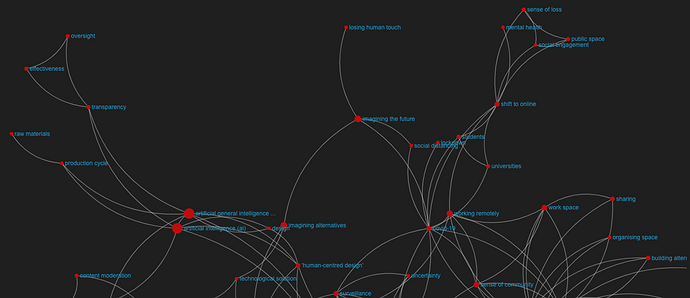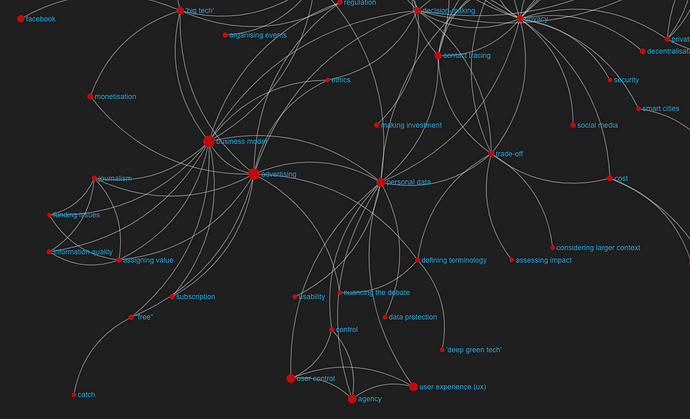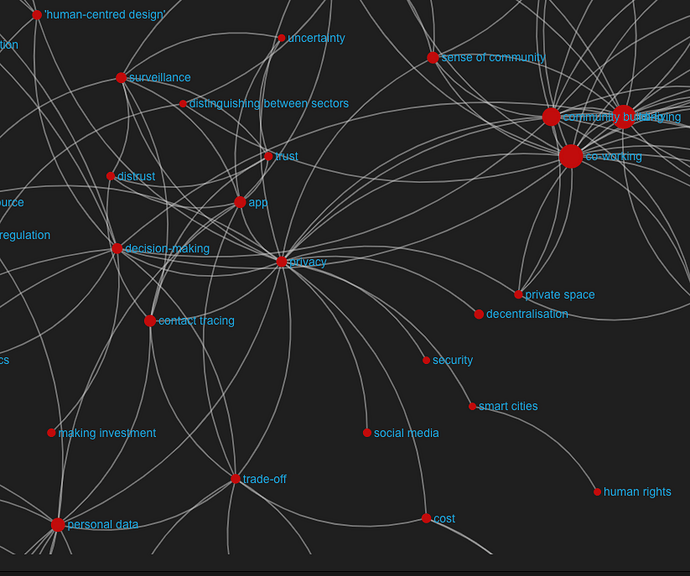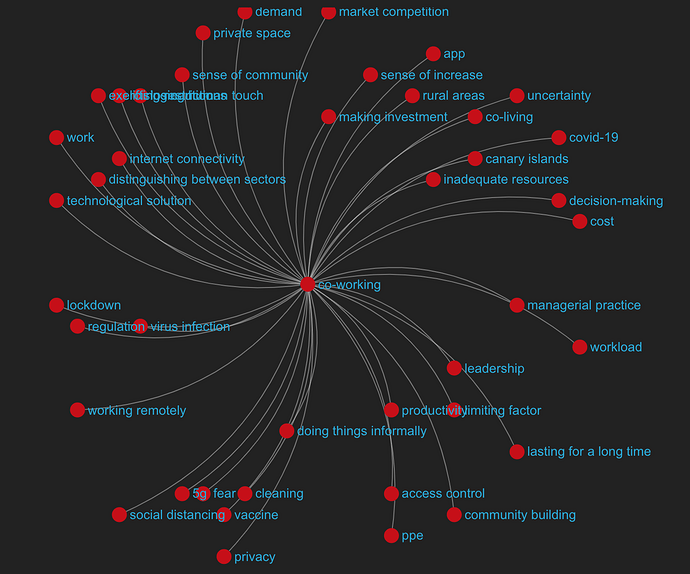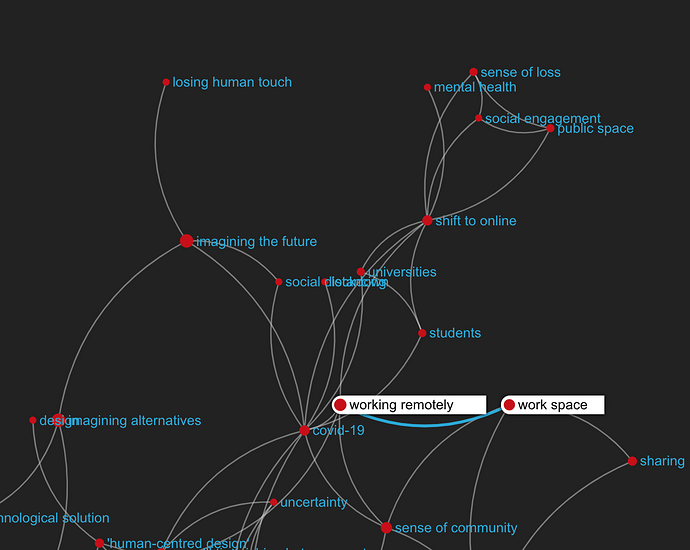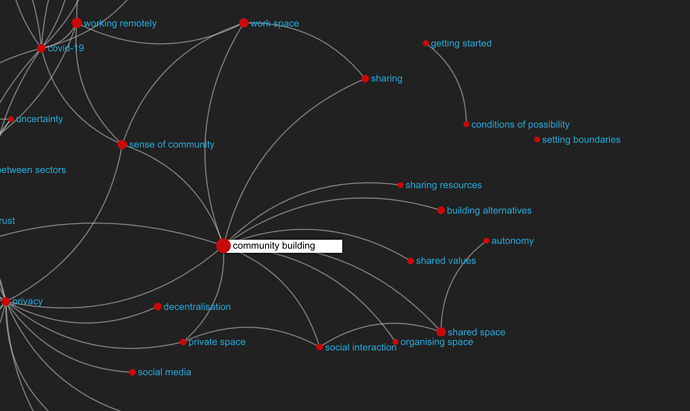Ethnographic Findings So Far

Since our last report in October 2019, the NGI ethnography team (@Amelia, @Leonie, and @katejsim) has been coding away and monitoring emerging themes in the Edgeryders community. While significant attention was paid to themes of technology, the internet and the environment in the latter part of 2019, 2020 has brought on a range of new topic areas, with crucial insights from a range of community members. In this report, we discuss some of the most salient themes we have observed thus far. We start with a broad overview, then dive into the Semantic Social Network to map these topics out based upon how community members are talking about them, and with whom.
Recurring Threads and New Conversations
Over the last four months, community members and managers have focussed increasing attention to the Covid-19 Pandemic, including an online event on the Surveillance Pandemic in April. During the call, members and invited experts discussed the risks and benefits of immunity certificates – as well as the uncertainty around immunity in general – the development and deployment of contact tracing apps and similar technologies; with most agreeing that the potential risks and harms to data privacy and civil liberties outweighed the potential for containing the virus. We also discussed, in great detail, the importance of coordination and cooperation across governments and communities, which many argued is more pressing than developing new technologies. We see more such events as a promising area for future analysis, as they generated deep and thoughtful conversation.
There have been a large volume of threads dedicated to issues around technology and Covid-19. Some key areas of community engagement include e-learning and remote work during lockdowns, the ways in which big tech is benefitting from the crisis caused by Covid-19, the development and deployment of contact tracing apps across Europe and its implications for data privacy, as well as many devoted to questions of the future of technology and work in the era of Covid-19.
While the Covid-19 pandemic has certainly been at the centre of community engagement, we also find a broad range of NGI threads devoted to other areas ( particularly in comparison to 2019) There are some recurring and overlapping topics in focus for the community, including detailed discussion on technology and surveillance, the development of smart cities, environmental issues and deep green technology, issues around monetisation of online resources like journalism, as well as Artificial Intelligence (AI) and Machine Learning (ML). One overlapping narrative in these core thematic areas is the need for destabilising the power monopoly that governments and big tech have over the future of the internet – and future of technology and its applications, more broadly. The consensus is often to (a) develop open source alternatives and (b) distribute control to a broader range of individuals and communities. The core messages being; rethink, reorganise, redistribute and improve. Interestingly, the problem statement is often at the institutional level (i.e. companies, monopolies, lack of strong regulation) but many of the proposed solutions are at the individual level (i.e. citizen education, individual open source code projects etc.). This may suggest a mismatch between problem and solution, which our community members have very actively and pointedly been addressing.
Particularly in light of the international anti-racism movement, we see a wide discussion of the ways in which digital technologies, AI and surveillance tools both contribute to racial inequity but also can affect meaningful change: the development of facial recognition technology disproportionately puts people of colour at risk of being targeted by law enforcement which has significant impact on social and economic mobility and enfranchisement, algorithms – as they are currently being programmed – produce and reproduce racial and ethnic bias, the internet has become a key messaging tool for right wing and white supremacist groups, and there is still wide racial disparity in technology research. We recommend efforts to bring in the expert knowledge of community members working on these issues into our discussions on platform. Doing so will help us highlight and uplift technological developments that are affecting change, crucial to a project on the Next Generation Internet which informs European Commission policy.
Exploring the NGI Semantic Social Network:
We find the most interesting co-occurrences when filtering the graph to k=4. For those unfamiliar with our tool, Graph Ryder, this means that we are looking the connections between codes that have been mentioned together by community members at least 4 times.
Let’s start with an overview of the conversation as a whole at k=4. This is everything that everyone is talking about across the NGI Forum.
!We can see some broad themes emerging as we look at the graph as a whole. Central nodes include codes like personal data, connected to codes like business model and advertising. From this personal data node, we get an idea of some of the issues community members are wrestling with.
If we follow the personal data code to advertising and business model to the left and trade-off to the right, we can see some very interesting debates emerging.
Trade-Offs and Decision-Making
It’s clear even at this level that the use of personal data sets up a trade-off for a lot of participants. In decision-making about sharing or protecting personal data, community members are considering larger context around its use and assessing the impact of the trade-off. cost is also a key consideration. Personal data also connects strongly, if we move south, to agency, in a highly illustrative cluster with control and user experience. We see, again, trade-offs set up – between user control and user experience, raising questions about what one gets when one gives up personal data, and how much control is possible. Community members also raise questions about the effort and cost of controlling personal data in the current environment, when responsibility is highly individualised (individualising responsibility is a salient code at a lower level of co-occurrences).
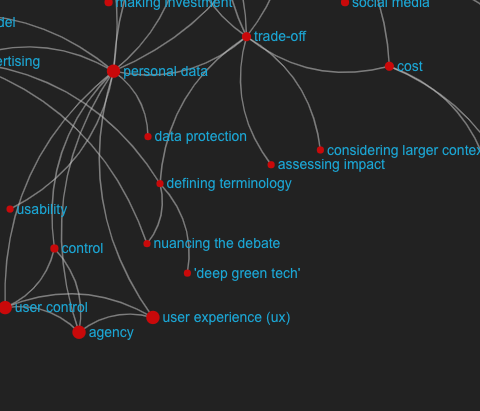
Moving these abstract concepts into concrete examples, we can look at the left of personal data to see these applied to the specific case of advertising and journalism. Selling personal data for advertising creates revenue for journalism, without which there is an issue of information quality. But there are other potential business models to be considered outside of the selling of personal data, like subscription models. We can also see that community members understand that "free" access to services is not always actually free, since the catch is the selling of their personal data. Yet journalism, without a sustainable business model, is facing some serious funding issues. The fundamental problem is about assigning value to things like journalism, which opens to the question of how to fund it without shady advertising practices. These are all strongly connected to the question of ethics, a key concern in journalism writ large which is closely tied to ethical considerations around advertising, monetisation, personal data, and how to construct a sustainable business model.
Regulating Big Tech, Finding Open Source Alternatives
Following the graph north, we can see business model and advertising also connected to monetisation and big tech. A series of issues around big tech have been outlined by the community – the need for regulation, the way it perpetuates inequality (facebook is a key example of big tech).
Alternatives to big tech emerge around open source, which has an interesting network built around it – questions of 'empowerment' (does open source empower users?), the need for training to use open source tools, and the question of whether using open source tools opens one up to increased risk. As a technological solution, open source also allows community members to imagine alternatives to the status quo. It also connects to 'human-centred design', as community members ask what exactly it would look like to design digital tools with and for humans.
open source also strongly connects with privacy, an extremely central node in the conversation. privacy connects back to personal data, and we see an illustrative network of privacy concerns articulated by the community: around smart cities and human rights, covid-19 and contact tracing, and as aforementioned, trade-off and decision-making. A salient theme is the question of how to weigh up privacy trade-offs, in order to make optimal decisions about one’s own data privacy. What does it cost? There is uncertainty around how extensive surveillance is, and a distrust of the information that one is given about these technologies, which makes making quality decisions about these issues difficult for community members.
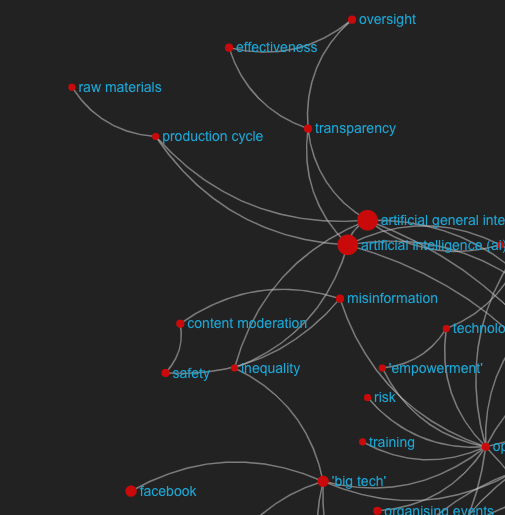
Also connected to ‘trade off’ and assessing impact is a series of environmental concerns. Moving to the bottom-right of the graph, questions of resource consumption and energy are tied to environmental sustainability and cost, showing us a snapshot of the rich conversation emerging on platform around technology, the internet, and environmental sustainability.
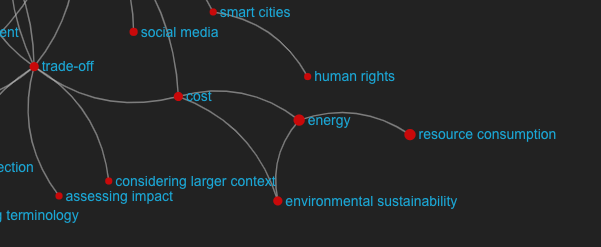
Returning to the topic of trust in technology, we see an interesting web of concepts emerging around artificial intelligence. AI is connected to inequality and big tech. It’s also connected to issues of transparency and oversight, as well as effectiveness. This cluster of codes tells us that there is an ongoing conversation around what kinds of oversight of AI might a) be actually effective, rather than performative and b) lead to increased transparency of AI and algorithms. We also see these connected to more concrete questions on what it takes to make these technological infrastructures: their production cycle and the raw materials needed.
Co-Working, Sharing Space
Since joining NGI Forward team in July, @katejsim has mostly been coding data about co-working and wanted to take the time to outline some preliminary findings. As the ego network below shows, we are starting to see some themes cohere around co-working. Since the pandemic, there is a growing demand for co-working spaces, including in rural areas with poor Internet connectivity. Co-working spaces, both formal and informal, are springing up to meet the technological and social needs of working remotely as workers relocate all around the world. Some have had to move for care responsibilities while others are relocating to areas in search of better quality of life. Whatever the reason, in the absence of the workplace providing natural space for social interaction, remote workers are seeking a sense of community.
For those operating formalised co-working spaces, their managerial practices of providing safe, clean, and socially distant working environment pose a real difficulty. On one hand, they want their services to last for a long time and see a real opportunity for market growth. However, with talks of the second lockdown and the uncertainty of social distancing guides in some countries, it is difficult to assess whether and how much to invest in operating or expanding facilities (making investment). For the moment, it appears that both the private and public sectors have responded to the demand for communal work spaces, but as the pandemic continues, operators are anticipating different business models for different sectors (distinguishing between sectors).
Some operators are turning to technological solutions like apps to monitor their facilities and regulate members’ access control. This raises some questions about privacy but operators seem to find access control apps to be the most practical option for the moment.
From loss to imagination
Putting co-working in conversation with other semantic nodes (at k=4) begins to tell a complex story about how the shift to online is restructuring social relations:
Following the threads around work from COVID-19 captures the double bind of having the pandemic disrupt the fabric of how we organise our working lives. On one hand, there is profound feeling of loss: the connections stemming from shift to online are public space, social engagement, mental health, and sense of loss. For most people, being unable to access public spaces on their own terms has severely restricted their social interaction. The loss of companionship and feeling of community is contributing to erosion in mental health. This was especially prescient with university students as their social and intellectual lives have had to move online.
At the same time, this sense of loss has also generated new opportunities as social distancing measures are propelling participants to think and act more creatively (imagining the future and imagining alternatives). More on this below.
Sharing spaces, building communities
Another strong connection emerging is on how sharing work space is contributing to a sense of community. Sense of community here captures both what co-working space members’ desire and what operators are doing to bring people together.
Sharing work space means having to share resources and, on some level, sharing, if not negotiating, values. Unsurprisingly, sharing work spaces with social distancing measures is incentivizing many to set boundaries. This code emerged from participants discussing how the burden of maintaining clean space often falls on those with higher standards of cleaning. (I’ve been having some issues with Graphryder on my computer where some connections are sometimes not shown, as is the case with setting boundaries here. Will discuss this at meeting tomorrow). In one recent thread I coded, a co-working space operator talked about the challenges of organising community-building events when everyone is experiencing 'Zoom fatigue'. How do you bring people together when the one way to connect people is tiring them out? I’ll be keeping track of this dynamic as our participants continue to reflect on the evolving social dynamics of working remotely.
Online-Offline Links, Zooming Out, and Defining Privacy
Following on @katejsim’s analysis of co-working above. I’d like to draw attention to the connections between the internet and online life and the concrete effects those have on life offline. We can see that covid-19 has lead to an increase of working remotely, perhaps unsurprisingly. But it has also lead to a shift of living conditions, particularly co-living and co-working, totally reshaping the division of public space and private space, leading community members to build alternatives and organising space differently.
Part of the impact of covid-19 has been a shift to online and a corresponding sense of loss, of public space, of social engagement, with mental health impacts. One way of addressing this has been to seek a sense of community by reworking offline spaces to increase social interaction. For students and universities, this is especially pressing.
@alberto points out that there is an interesting structural anomaly at k≥5. In the giant component (there are several small ones too, not shown in the picture), one single edge personal data <=> privacy connects two otherwise fully autonomous clusters. The left cluster seems to be about economic sustainability, business models and their social consequences. The right cluster is more concerned with values and the public sphere.
He asks: could this be a promising way of reading the data?
My response is: Potentially. Although I think that the fact that big tech and privacy are on different sides of this might complicate this answer, because I think as we continue to code, big tech and facebook will creep over to the privacy and surveillance side of the graph, potentially disturbing this dichotomy.
It’s also interesting to trace privacy as a code in general, because it’s making us connect two things we often consider separate — privacy on the internet and privacy in real life. I think we are going to end up writing something incredibly interesting on the way that people configure notions of privacy, how it relates to private and public space, and what kind of ‘space’ the internet is. Privacy and autonomy also connect to building communities, both offline and online.
I actually think @matthias’ post on work-life balance vs work-life integration is going to be super interesting as a way in to thinking about this — there’s already great research on the disappearance of work-life separation, mediated by the dissolution of public-private boundaries enabled by the internet, and this is way pre-covid.
The great thing about anthropology is that it doesn’t take these changes as negative (just like @matthias, who sees it as enabling him to live his life in a more integrated way that matches his own personal rhythm). The way this interfaces with living and working with others, tacking between autonomy and shared space, sense of community I think is going to be absolutely fascinating. I also love the connections with imagining the future and building alternatives… the next generation internet is about more than just the online world, for sure, and I think what we bring to bear on it is this question of what it does to communities, how we make them, and how we imagine other worlds together, through our everyday practices.
A code I want to keep tracking is of defining terminology, as NGI community members try to cut to the heart of some of the bigger, buzzier issues in tech and the internet. 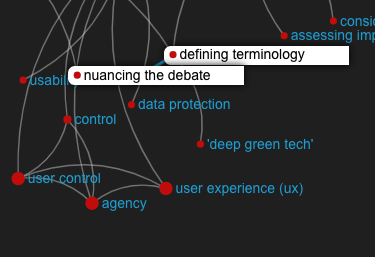
The code is meaningfully connected to nuancing the debate, telling us something about how to move forward and tackle the thornier, more challenging issues in this area in meaningful ways. I’m excited to keep seeing how these conversations unfold.
